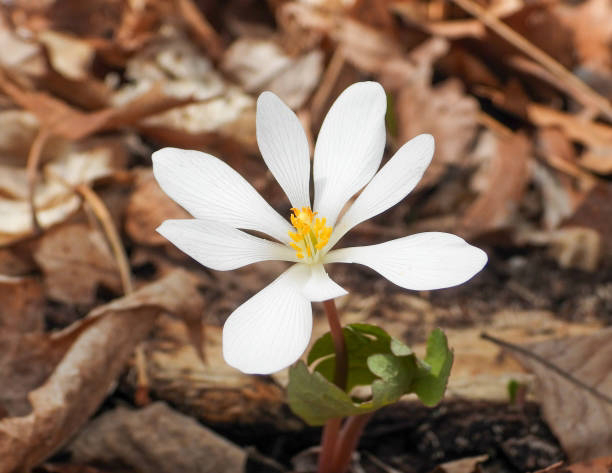Amidst the tranquil woods of early spring, a fleeting beauty emerges - the bloodroot. With its delicate white blooms and vibrant red sap, it captivates the forest floor, hinting at ancient secrets. Join us as we journey into the enigmatic realm of bloodroot, unraveling its mysteries and discovering the hidden wonders of nature's scarlet jewel.
1. Spring's Fleeting Beauty:
In the early days of spring, a remarkable sight graces the forest floor - the bloodroot. This delicate flower, with its single white bloom, emerges briefly, catching the eye before the surrounding trees burst into full leaf. Its presence is ephemeral, lasting only a few precious days, yet within this short window, it epitomizes the one rapid bursts of life and beauty that characterize the changing seasons.
2. The Colorful Bloodroot:
True to its name, the bloodroot holds a fascinating secret within its petals. When the plant is bruised or injured, it exudes a brilliant red-orange sap, a striking contrast against its white blooms. This vibrant "blood" has a storied history, as Native American tribes once utilized it as a natural dye for coloring clothing, baskets, and even war paint, infusing their cultural artifacts with vivid hues drawn straight from nature's palette.
3. Nature's Protective Potion:
Beyond its aesthetic appeal, the bloodroot's red sap serves a crucial purpose in its survival. This vivid hue is not merely for show; it contains a potent compound called sanguinarine. This alkaloid acts as a powerful deterrent against hungry insects and herbivores, effectively functioning as a natural bodyguard for the plant's delicate leaves and flowers. In this way, the bloodroot ingeniously defends itself against potential threats in its woodland habitat.
4. Hidden Partnerships Below:
Beneath the surface, the bloodroot forms a silent partnership with mycorrhizal fungi. These microscopic organisms establish a symbiotic relationship with the plant, exchanging essential nutrients and water from the soil for sugars produced through photosynthesis. This underground alliance provides the bloodroot with vital resources for growth and sustenance, demonstrating the interconnectedness of life within the forest ecosystem.
5. Nature's Pollination Plan:
As an early bloomer, the bloodroot faces a unique challenge in ensuring pollination before the arrival of other spring flowers. To overcome this obstacle, nature has devised a clever strategy. The bloodroot's showy flowers attract early pollinators with their bright coloration and sweet nectar. However, should external pollinators fail to visit, the plant possesses the ability for self-pollination, ensuring the continuation of its lineage and the dispersal of its genetic material.
6. Spring's Arrival Announcement:
In the tranquil woodland setting, the emergence of bloodroot flowers serves as a symbolic herald of spring's arrival. These delicate blooms, peeking through the forest floor's carpet of fallen leaves, mark a time of renewal and rejuvenation after the long slumber of winter. Their presence is a welcome sight for nature enthusiasts and a gentle reminder of the cyclical nature of life in the natural world.
7. Threats to a Natural Gem:
Despite its beauty and ecological significance, the bloodroot faces numerous threats to its continued existence. Habitat loss, driven by urbanization and deforestation, poses a significant risk to its woodland habitat. Additionally, over-collection for its vibrant sap and perceived medicinal properties further jeopardizes its populations. Preserving the bloodroot's natural habitat and advocating for sustainable harvesting practices are essential steps in safeguarding this botanical treasure for future generations to appreciate.
8. Beauty with a Poisonous Side:
While the bloodroot's fleeting blooms may captivate the observer, it harbors a hidden danger within its delicate façade. All parts of the plant, including its roots, leaves, and sap, contain toxic compounds known as alkaloids. Ingestion of even small amounts can lead to severe toxicity in humans and animals alike. Therefore, while admiring the bloodroot's ephemeral charm, it is crucial to exercise caution and appreciate its beauty from a safe distance.
9. The Tenacity of Bloodroot:
Despite its short lifespan and the myriad challenges it faces, the bloodroot perseveres with remarkable resilience. Adapted to thrive in the dappled shade of woodland environments, this unassuming plant harbors a wealth of unique adaptations that enable it to flourish amidst adversity. Its ability to overcome obstacles and thrive in the face of change serves as a poignant reminder of the resilience of life in the natural world, offering a captivating story waiting to be discovered by those who pause to admire its fleeting beauty.





